The collection
The works inherited by Dieter Scharf from his grandfather's collection include graphics by Goya, [3] Hugo, Klinger, Manet, Meryon [3] and Piranesi. The works by these artists formed the foundation on which Scharf built his own collection of symbolist and surrealist art.
Besides paintings by Dalí, Dubuffet, Ernst, Magritte, Masson, Moreau, Redon, Rousseau and Tanguy, as well as sculptures by Ernst, Laurens, Lipchitz and Tàpies, the key works of the collection are graphics, following the example set by Gerstenberg. Other artists in the collection include Baumeister, Bellmer, Brauner, Éluard, Ensor, Giacometti, Grosz, Janssen, Klee, Léger, Miró, Munch, Oelze, Picabia, Picasso, Schwitters, Seurat, Tobey, and Wols.
The Scharf-Gerstenberg Collection thematically complements the exhibition "Picasso and His Time" in the Berggruen Museum located opposite. [7] Some artists, such as Picasso, Klee and Giacometti, are featured in both collections. The Kalabsha Gate and the columns from the ancient Sahure Temple, both owned by the Egyptian Museum, will also be on display in the Scharf-Gerstenberg Museum until the completion of the Pergamon Museum's fourth exhibition wing. [2] [8] [9]

Alberto Giacometti was a Swiss sculptor, painter, draftsman and printmaker. Beginning in 1922, he lived and worked mainly in Paris but regularly visited his hometown Borgonovo to see his family and work on his art.

Charlottenburg is a locality of Berlin within the borough of Charlottenburg-Wilmersdorf. Established as a town in 1705 and named after Sophia Charlotte of Hanover, Queen consort of Prussia, it is best known for Charlottenburg Palace, the largest surviving royal palace in Berlin, and the adjacent museums.

The Egyptian Museum of Berlin is home to one of the world's most important collections of ancient Egyptian artefacts, including the iconic Nefertiti Bust. Since 1855, the collection is a part of the Neues Museum on Berlin's Museum Island, which reopened after renovations in 2009.

Schloss Charlottenburg is a Baroque palace in Berlin, located in Charlottenburg, a district of the Charlottenburg-Wilmersdorf borough.
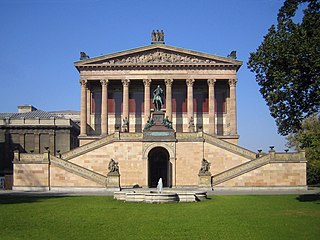
The Alte Nationalgalerie is a listed building on the Museum Island in the historic centre of Berlin, Germany. The gallery was built from 1862 to 1876 by the order of King Frederick William IV of Prussia according to plans by Friedrich August Stüler and Johann Heinrich Strack in Neoclassical and Renaissance Revival styles. The building's outside stair features a memorial to Frederick William IV. Currently, the Alte Nationalgalerie is home to paintings and sculptures of the 19th century and hosts a variety of tourist buses daily. As part of the Museum Island complex, the gallery was inscribed on the UNESCO World Heritage List in 1999 for its outstanding architecture and its testimony to the development of museums and galleries as a cultural phenomenon in the late 19th century.
The Thannhauser Galleries were established by the Thannhauser family in early 20th century Europe. Their cutting-edge exhibitions helped forge the reputations of many of the most important Modernist artists.

The Museum Ostwall is a museum of modern and contemporary art in Dortmund, Germany. It was founded in the late 1940s, and has been located in the Dortmund U-Tower since 2010. The collection includes paintings, sculptures, objects and photographs from the 20th century, plus over 2,500 graphics, spanning Expressionism through classic modern art to the present day.

Friedrich August Stüler was an influential Prussian architect and builder. His masterpiece is the Neues Museum in Berlin, as well as the dome of the triumphal arch of the main portal of the Berliner Schloss.

Heinz Berggruen was a German-born American art dealer and collector who sold 165 works of art to the German federal government to form the core of the Berggruen Museum in Berlin, Germany. He was the father of John, Olivier and Nicolas Berggruen.

The Prussian Cultural Heritage Foundation is a German federal government body that oversees 27 museums and cultural organizations in and around Berlin, Germany. Its purview includes all of Berlin's State Museums, the Berlin State Library, the Prussian Privy State Archives and a variety of institutes and research centers. As such, it is one of the largest cultural organizations in the world, and also the largest cultural employer in Germany with around 2,000 staff as of 2020. More than four million people visited its museums in 2019.

The Staatliche Museen zu Berlin are a group of institutions in Berlin, Germany, comprising seventeen museums in five clusters; several research institutes; libraries; and supporting facilities. They are overseen by the Prussian Cultural Heritage Foundation and funded by the German federal government in collaboration with Germany's federal states. The central complex on Museum Island was added to the UNESCO list of World Heritage Sites in 1999. By 2007, the Staatliche Museen zu Berlin had grown into the largest complex of museums in Europe. The museum was originally founded by King Friedrich Wilhelm III of Prussia in 1823 as the Königliche Museen.
The Antikensammlung Berlin is one of the most important collections of classical art in the world, now held in the Altes Museum and Pergamon Museum in Berlin, Germany. It contains thousands of ancient archaeological artefacts from the ancient Greek, Roman, Etruscan and Cypriot civilizations. Its main attraction is the Pergamon Altar and Greek and Roman architectural elements from Priene, Magnesia, Baalbek and Falerii. In addition, the collection includes a large number of ancient sculptures, vases, terracottas, bronzes, sarcophagi, engraved gems and metalwork.

The Kunstmuseum Basel houses the oldest public art collection in the world and is generally considered to be the most important museum of art in Switzerland. It is listed as a Swiss heritage site of national significance.

The Staatliche Graphische Sammlung in Munich (München), Germany, is a large collection of drawings, prints and engravings. It contains 400,000 sheets starting from the 15th century from various artists around the world. Along with Kupferstichkabinett Berlin and Kupferstichkabinett Dresden, it is the most important collection of its kind in Germany. It is owned by the government of Bavaria and located within the Kunstareal, a museum quarter in the city centre of Munich.
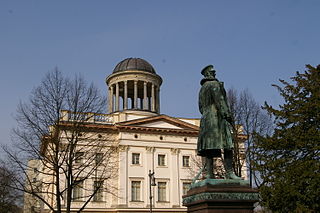
The Berggruen Museum is a collection of modern art classics in Berlin, which the collector and dealer Heinz Berggruen, in a "gesture of reconciliation", gave to his native city. The most notable artists on display include Pablo Picasso, Alberto Giacometti, Georges Braque, Paul Klee and Henri Matisse. The Berggruen Collection is part of the National Gallery of Berlin.
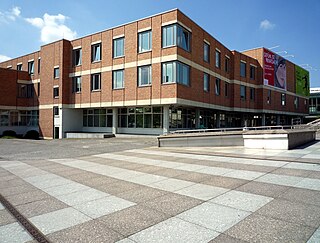
The Kupferstichkabinett, or Museum of Prints and Drawings, is a prints museum in Berlin, Germany. It is part of the Berlin State Museums, and is located in the Kulturforum on Potsdamer Platz. It is the largest museum of graphic art in Germany, with more than 500,000 prints and around 110,000 individual works on paper.
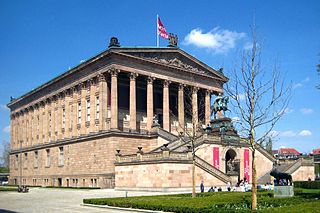
The National Gallery in Berlin, Germany, is a museum for art of the 19th, 20th and 21st centuries. It is part of the Berlin State Museums. From the Alte Nationalgalerie, which was built for it and opened in 1876, its exhibition space has expanded to include five other locations. The museums are part of the Berlin State Museums, owned by the Prussian Cultural Heritage Foundation.

Otto Gerstenberg was a German entrepreneur, mathematician and an early 20th-century Berlin art collector.
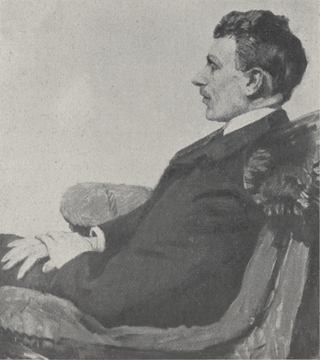
Alfred Gold was an Austrian writer, theatre critic, journalist, art collector, and dealer.
Siegfried Rosengart was a German-Swiss art dealer.


















